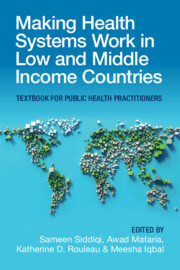 Making Health Systems Work in Low and Middle Income Countries
Making Health Systems Work in Low and Middle Income Countries from Section 2 - Transforming Health Systems: Confronting Challenges, Seizing Opportunities
Published online by Cambridge University Press: 08 December 2022
Governments across L&MICs are exploring public private partnership (PPP) as a policy option to improve access to health care services for its citizens, in their journey towards UHC. The scope and objectives of PPPs in health care sector are primarily threefold: i) to augment healthcare infrastructure such as hospitals, ii) to improve service delivery effectiveness; and iii) financing or purchasing of services from the private sector to mitigate impoverishment of the vulnerable population. PPPs are complex professional contracts. Political and administrative commitment, stakeholder engagement, and building trust are key foundations to public private partnerships. Policy, legal and institutional framework, regulatory ecosystem, and organizational capacities with fiscal support are key ingredients for effective partnerships.
To save this book to your Kindle, first ensure [email protected] is added to your Approved Personal Document E-mail List under your Personal Document Settings on the Manage Your Content and Devices page of your Amazon account. Then enter the ‘name’ part of your Kindle email address below. Find out more about saving to your Kindle.
Note you can select to save to either the @free.kindle.com or @kindle.com variations. ‘@free.kindle.com’ emails are free but can only be saved to your device when it is connected to wi-fi. ‘@kindle.com’ emails can be delivered even when you are not connected to wi-fi, but note that service fees apply.
Find out more about the Kindle Personal Document Service.
To save content items to your account, please confirm that you agree to abide by our usage policies. If this is the first time you use this feature, you will be asked to authorise Cambridge Core to connect with your account. Find out more about saving content to Dropbox.
To save content items to your account, please confirm that you agree to abide by our usage policies. If this is the first time you use this feature, you will be asked to authorise Cambridge Core to connect with your account. Find out more about saving content to Google Drive.